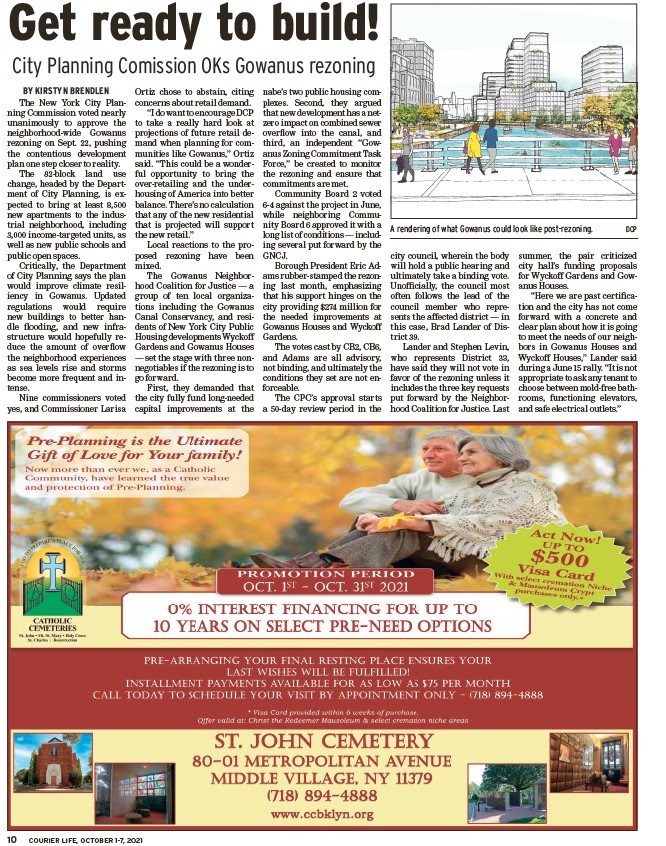
BY KIRSTYN BRENDLEN
The New York City Planning
Commission voted nearly
unanimously to approve the
neighborhood-wide Gowanus
rezoning on Sept. 22, pushing
the contentious development
plan one step closer to reality.
The 82-block land use
change, headed by the Department
of City Planning, is expected
to bring at least 8,500
new apartments to the industrial
neighborhood, including
3,000 income-targeted units, as
well as new public schools and
public open spaces.
Critically, the Department
of City Planning says the plan
would improve climate resiliency
in Gowanus. Updated
regulations would require
new buildings to better handle
fl ooding, and new infrastructure
would hopefully reduce
the amount of overfl ow
the neighborhood experiences
as sea levels rise and storms
become more frequent and intense.
Nine commissioners voted
yes, and Commissioner Larisa
Ortiz chose to abstain, citing
concerns about retail demand.
COURIER L 10 IFE, OCTOBER 1-7, 2021
“I do want to encourage DCP
to take a really hard look at
projections of future retail demand
when planning for communities
like Gowanus,” Ortiz
said. “This could be a wonderful
opportunity to bring the
over-retailing and the underhousing
of America into better
balance. There’s no calculation
that any of the new residential
that is projected will support
the new retail.”
Local reactions to the proposed
rezoning have been
mixed.
The Gowanus Neighborhood
Coalition for Justice — a
group of ten local organizations
including the Gowanus
Canal Conservancy, and residents
of New York City Public
Housing developments Wyckoff
Gardens and Gowanus Houses
— set the stage with three nonnegotiables
if the rezoning is to
go forward.
First, they demanded that
the city fully fund long-needed
capital improvements at the
nabe’s two public housing complexes.
Second, they argued
that new development has a netzero
impact on combined sewer
overfl ow into the canal, and
third, an independent “Gowanus
Zoning Commitment Task
Force,” be created to monitor
the rezoning and ensure that
commitments are met.
Community Board 2 voted
6-4 against the project in June,
while neighboring Community
Board 6 approved it with a
long list of conditions — including
several put forward by the
GNCJ.
Borough President Eric Adams
rubber-stamped the rezoning
last month, emphasizing
that his support hinges on the
city providing $274 million for
the needed improvements at
Gowanus Houses and Wyckoff
Gardens.
The votes cast by CB2, CB6,
and Adams are all advisory,
not binding, and ultimately the
conditions they set are not enforceable.
The CPC’s approval starts
a 50-day review period in the
A rendering of what Gowanus could look like post-rezoning. DCP
city council, wherein the body
will hold a public hearing and
ultimately take a binding vote.
Unoffi cially, the council most
often follows the lead of the
council member who represents
the affected district — in
this case, Brad Lander of District
39.
Lander and Stephen Levin,
who represents District 33,
have said they will not vote in
favor of the rezoning unless it
includes the three key requests
put forward by the Neighborhood
Coalition for Justice. Last
summer, the pair criticized
city hall’s funding proposals
for Wyckoff Gardens and Gowanus
Houses.
“Here we are past certifi cation
and the city has not come
forward with a concrete and
clear plan about how it is going
to meet the needs of our neighbors
in Gowanus Houses and
Wyckoff Houses,” Lander said
during a June 15 rally. “It is not
appropriate to ask any tenant to
choose between mold-free bathrooms,
functioning elevators,
and safe electrical outlets.”
Get ready to build!
City Planning Comission OKs Gowanus rezoning